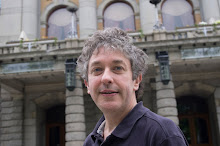 |
| A celebrated author, yesterday |
I was struck not just by the physical manifestation of so many books laid out on the table – all real – but also the people in the room who, whether they were quoted in the book or not (and many of them were), were a cross-section of the Fringe community.
Among the crowd were Tomek Borkowy, director of the New Town Theatre; Laura Mackenzie Stuart of Creative Scotland; Judith Doherty and Debroah Crew of Grid Iron; Keith Bruce, arts editor of the Herald; Joyce McMillan, theatre critic on the Scotsman; Kath Mainland and her team from the Fringe Office; Claire Wood from Edinburgh Graduate Theatre Group; Andrew Dixon, chief executive of Creative Scotland; Neil Cooper, theatre critic on the Herald; Thom Dibdin, theatre critic for the Stage; Trish McGuinness, arts publicist; Laura Cameron Lewis, producer and theatre-maker; Dani Rae, theatre producer; Mhari Hetherington, arts administrator; Dana MacLeod of the British Council; Shona Craven of onstagescotland.com; Malcolm Kennedy, in charge of public entertainment licensing at the City of Edinburgh Council; Sam Gough of the EICC; Trisha Emblem, former deputy administrator of the Fringe Society; Amy Taylor of TV Bomb and . . . well, you get the picture.
First, Anna Brewer, my editor from Methuen Drama, gave a very generous speech. She described how she'd come up with the idea of a book about how to do a show on the Edinburgh Festival Fringe and sent her proposal to an unknown theatre critic (me) to comment on. One of her questions was about who should write the book, whether it should be a Fringe insider, a collection of specialists or a single author. This she remembered, was my reply: "As a freelance journalist, I am biased. Not only do I think there should be a single author, but I think it should be me."
It did the trick.
In my speech, I described how my favourite section of the book was the index. This, I explained, was partly because, as the son of two librarians, I had a weird thing about alphabeticalisation. It was also because the juxtaposition of entries in the index summed up the endlessly fascinating, multifarious nature of the Fringe.
To give an example, I asked the assembled group for a letter of the alphabet. Someone shouted out "P". I began reading from the book:
- Palace of Holyroodhouse - the Edinburgh residence of the queen
- Palin, Michael - a sometime Fringe performer
- Paradise is Closing Down - a play by Pieter-Dirk Uys which was the first ever show brought to Edinburgh by William Burdett-Coutts, artistic director of Assembly
- Parks, Brian - the New York playwright whose work was brought to Edinburgh by John Clancy
- Parsons, Nicholas - BBC entertainer and regular visitor to the city
- Passion Flower - a cabaret show by jazz singer Becc Sanderson
- PBH Free Fringe - Peter Buckley Hill's innovative way of keeping costs down
- Pearson, Debbie - co-director of the similarly innovative Forest Fringe
- Penelope - a play by Enda Walsh
My point, in a speech designed to thank people and say "it couldn't have happened without . . .", was that the book, like the Fringe itself, couldn't have happened without this amazing collision of disparate elements. That's one of the things that made it a joy to write and that, year after year, makes the Edinburgh Festival Fringe the most exciting place on the planet.
If you've had anything to do with it at all - thank you.





No comments:
Post a Comment